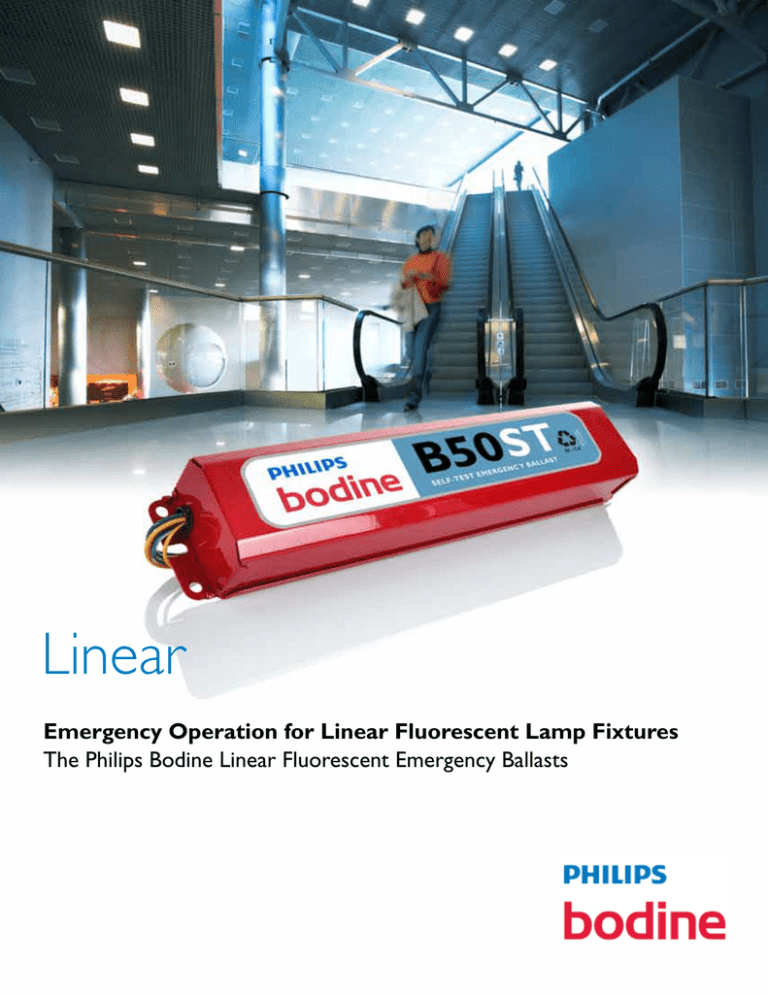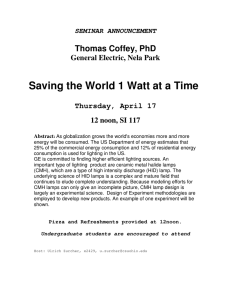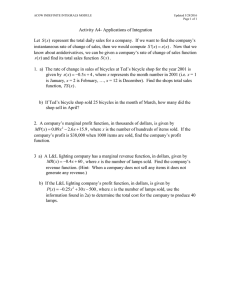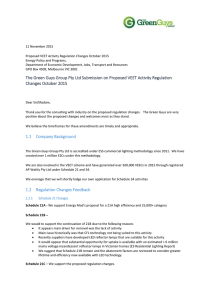
Linear
Emergency Operation for Linear Fluorescent Lamp Fixtures
The Philips Bodine Linear Fluorescent Emergency Ballasts
Philips Bodine fluorescent emergency ballasts allow you to
convert virtually any new or existing fluorescent fixture
into code-compliant emergency lighting.
Linear
Philips Bodine linear fluorescent emergency
ballasts (FEBs) are designed specifically for
linear lamp fluorescent fixtures. These emergency ballasts allow you to convert virtually
any new or existing fluorescent fixture into
code-compliant emergency lighting. Singlelamp or multilamp fixtures fitted with T5-T12
lamps can be converted using a Philips Bodine
linear FEB.
Philips Bodine linear FEBs are compatible with
most electronic, standard, energy-saving and
dimming AC ballasts, as well as with energy
management systems, such as occupancy
detectors and photo sensors. In addition, the
wide variety of linear products we design
and build means that we have something for
almost every emergency lighting application,
including indoor-dry, damp, extended
temperature, extended runtime, self-testing
and remote testing.
What is a Fluorescent Emergency
Ballast?
A FEB is a battery-powered device that, in
the absence of normal AC power, supports
one or more fluorescent lamps, providing a
minimum 90 minutes of emergency lighting. Emergency lighting is vital to life safety
programs and is required in all commercial,
industrial and institutional facilities. When
normal power fails, emergency lighting guides
building occupants along the path of egress
to designated exits and helps them avoid
obstacles en route.
Fluorescent emergency ballasts allow you to use the same light
source for normal and emergency lighting. Because the same
light source is used, emergency lighting looks similar to normal
lighting – no drastic lighting changes or unwanted glare results.
2
Linear brochure
Linear brochure
3
FEB vs. AC Ballast
Fluorescent lamps require AC ballasts for
start-up and for current regulation during
normal operation. When AC power fails and
normal lamp operation ceases, Philips Bodine
battery-powered FEBs are critical. FEBs supply
power to the lamp(s) and allow the lamp(s)
to provide full or reduced illumination for a
minimum of 90 minutes in compliance with
national safety codes for emergency lighting
(e.g., NFPA® Life Safety Code®, National
Electrical Code®).
FEB Installation
FEB Operation
When AC power fails, Philips Bodine FEBs immediately switch to emergency mode, operating one, two or three lamps for a minimum of
90 minutes. When AC power is restored, the
emergency ballasts return to charging mode.
FEBs are fully recharged in 24 hours.
4
Linear brochure
Philips Bodine FEBs may be used with either a
switched or unswitched fixture. If a switched
fixture is used, an unswitched hot lead must
be connected to the emergency ballast. The
emergency ballast must be fed from the same
branch circuit as the AC ballast. Philips Bodine
FEBs may be installed inside, on top of or
remote from the fixture, depending on factors
such as FEB model and fixture type.
Philips Bodine FEBs truly provide emergency lighting you’ll
never see … until you need it.
Linear Lamp ID
Linear fluorescent lamps are given designations
such as T5, T8 and T12. The “T” indicates the
Code Compliance
Philips Bodine FEBs are tested by Underwriters
Laboratories (UL) in compliance with standards set forth
in UL 924, Emergency Lighting and Power Equipment.*
Products are UL Listed for factory and field installation
or UL Component Recognized for factory installation
only. Emergency illumination time exceeds the National
Electrical Code, Life Safety Code and UL 90-minute
requirements.
lamp is linear, while the number is the diameter
of the lamp measured in eighths of an inch.
A T12, for example, is 12/8” and the T5 is 5/8”.
T5 .625” / 16mm
*Products tested to meet standards for the Canadian Standards Association
(CSA) and Normas Oficiales Mexicanas (NOM) are also available. Please
check with the factory at 800-223-5728 for more information.
FEB Benefits
Fluorescent emergency ballasts allow you to use the same
light source for normal and emergency lighting. Because
the same light source is used, emergency lighting looks
similar to normal lighting – no drastic lighting changes or
unwanted glare results. In addition, the FEBs’ unobtrusive
installation does not detract from interior design or encourage vandal activity. Philips Bodine FEBs truly provide
emergency lighting you’ll never see … until you need it.
T8 1” / 26mm
T12 1.5” / 38 mm
Lamp
Inches
guides building occupants along the path of
T5 .625” 16 mm
egress to designated exits and helps them
T8 1” 26 mm
T9
1.125” 29 mm
T10 1.25” 32 mm
T12 1.5” 38 mm
When normal power fails, emergency lighting
avoid obstacles en route.
Millimeters
Linear brochure
5
Why Philips Bodine FEBs?
Philips Bodine emergency ballasts paired with
fluorescent fixtures:
1.) Provide instant backup lighting
2.) Complement original lighting design
3.) Supply lighting that looks like normal lighting
4.) Mount inconspicuously inside, on top of or remote from the fixture to reduce the risk of tampering and vandalism
5.)
6
Install quickly and easily to save time, labor and money. A qualified electrician can typically install a Philips Bodine emergency ballast in less than 30 minutes.
Linear brochure
Philips Bodine emergency ballasts mount
inconspicuously inside, on top of or remote
from the fixture to reduce the risk of
tampering and vandalism.
Life Safety
7.9.2 Performance of System.
7.9.2.1 Emergency illumination shall be provided for a minimum of 1½ hours in the event of failure
of normal lighting. Emergency lighting facilities shall be arranged to provide initial illumination that is
not less than an average of 1 ft-candle (10.8 lux) and, at any point, not less than 0.1 ft-candle (1.1 lux),
measured along the path of egress at floor level. Illumination levels shall be permitted to decline to not
less than an average of 0.6 ft-candle (6.5 lux) and, at any point, not less than 0.06 ft-candle (0.65 lux)
at the end of 1½ hours. A maximum-to-minimum illumination uniformity ratio of 40 to 1 shall not
be exceeded.
7.9.3 Periodic Testing of Emergency Lighting Equipment.
7.9.3.1 Required emergency lighting systems shall be tested in accordance with one of the three
options offered by 7.9.3.1.1, 7.9.3.1.2, or 7.9.3.1.3.*
7.9.3.1.1 Testing of required emergency lighting systems shall be permitted to be conducted as follows:
(1)
(2)
(3)
(4)
(5)
Functional testing shall be conducted monthly with a minimum of 3 weeks and a maximum of 5 weeks between tests, for not less than 30 seconds, except as otherwise permitted by 7.9.3.1.1(2).
The test interval shall be permitted to be extended beyond 30 days with the approval of the authority having jurisdiction.
Functional testing shall be conducted annually for a minimum of 1½ hours if the emergency lighting system is battery powered.
The emergency lighting equipment shall be fully operational for the duration of the tests required by 7.9.3.1.1(1) and 7.9.3.1.1(3).
Written records of visual inspections and tests shall be kept by the owner for inspection by the authority having jurisdiction.
(Life Safety Code® 2009)
*7.9.3.1.2 and 7.9.3.1.3 describe testing requirements for self-testing/self-diagnostic battery-operated emergency
lighting systems and computer-based self-testing/self-diagnostic battery-operated emergency lighting systems,
respectively. Monthly 30-second and annual 90-minute tests are included for both. They were omitted here because of
space constraints. Please see LSC 7.9.3 (2009) for complete testing information.
Linear brochure
7
Linear Products
Model
# Lamps
Max.
Lumens
Types of Lamps Operated
Features
B33
2 or 3
3400
Two or three 32 W (4’) T8s; or two or three 39 W or two 40 -55 W (4-pin) long
compacts. For use with instant start parallel AC ballasts only
3-lamp parallel illumination
B30 *
1 or 2
3500
One 17-215 W (2’- 8’) or two 17-40 W (2’- 4’) T8, T9 , T10 or T12 lamps; one 18-55 W or
two 18 -39 W (4-pin) long compacts; or one 21-54 W (2’- 4’) standard or high output T5
High lumen output; ELC
B30RCT
1 or 2
3500
One 17-215 W (2’- 8’) or two 17-40 W (2’- 4’) T8, T9 , T10 or T12 lamps; one 18-55 W or
two 18 -39 W (4-pin) long compacts; or one 21-54 W (2’- 4’) standard or high output T5
Remote control testing
B30ST *
1 or 2
3500
One 17-215 W (2’- 8’) or two 17-40 W (2’- 4’) T8, T9 , T10 or T12 lamps; one 18-55 W or
two 18 -39 W (4-pin) long compacts; or one 21-54 W (2’- 4’) standard or high output T5
Automatic self-testing; ELC
B50 *
1 or 2
1400
One 17-215 W (2’- 8’) or two 17-40 W (2’- 4’) T8, T9 , T10 or T12 lamps; or one 18-55 W
or two 18 -39 W (4-pin) long compacts
Specification grade; ELC
B50Cold-Pak
1 or 2
1200
One 17-215 W (2’- 8’) or two 17-40 W (2’- 4’) T8, T9 , T10 or T12 lamps; or one 18-55 W
or two 18 -39 W (4-pin) long compacts
Extreme temperatures
B50RCT
1 or 2
1400
One 17-215 W (2’- 8’) or two 17- 40 W (2’- 4’) T8, T9 , T10 or T12 lamps; or one 18 -55 W
or two 18 -39 W (4-pin) long compacts
Remote control testing
B50ST *
1 or 2
1400
One 17-215 W (2’- 8’) or two 17-40 W (2’- 4’) T8, T9 , T10 or T12 lamps; or one 18-55 W
or two 18 -39 W (4-pin) long compacts
Automatic self-testing; ELC
B60 *
1 or 2
700
One 17-215 W (2’- 8’) or two 17-40 W (2’- 4’) T8, T9 , T10 or T12 lamps; or one 18-55 W
or two 18 -39 W (4-pin) long compacts
Standard grade; ELC
B70A * +
1
700
One 17-215 W (2’- 8’) T8, T10 or T12 lamp or one (4-pin) long compact.
2-hr runtime, not recommended with reduced-wattage, energy-saving T8 lamps
2-hour runtime; ELC
B90 * +
1
600
One 17-215 W (2’- 8’) T8, T10 or T12 lamp or one (4-pin) long compact.
Not recommended with reduced-wattage, energy-saving T8 lamps
Minimum code-compliance grade; ELC
B100 * +
1
450
One 17-40 W (2’- 4’) T8, T10 or T12 lamp or one (4-pin) long compact.
Not recommended with reduced-wattage, energy-saving T8 lamps
Economical alternative; ELC
LP600STU
1
1325
One 14-54 W (2’- 4’) standard or high output T5; 17-55 W (2’-5’) T8; 36-55 W (4-pin)
long compact; or 22-55 W T5 circline
Low-profile fixtures; Self-testing; Ideal for lowmercury (green) lamps; Universal input; ELC
LP600
1
1325
One 14-54 W (2’- 4’) standard or high output T5; 17-55 W (2’-5’) T8; 36-55 W (4-pin)
long compact; or 22-55 W T5 circline
Low-profile fixtures; Ideal for low-mercury
(green) lamps; ELC
LP550
1
700
One 14-54 W (2’- 4’) standard or high output T5; 32-44 W (4’-5’) standard or high output
T8; or 36-55 W (4-pin) long compact
Low-profile fixtures; Ideal for low-mercury
(green) lamps; ELC
LP500
1
700
One 21-54 W (2’- 4’) standard or high output T5 or 32 W (4’) T8
Low-profile fixtures; Ideal for low-mercury
(green) lamps; ELC
B50LP
1 or 2
1300
One 17-215 W (2’- 8’) or two 17-40 W (2’- 4’) T8, T9, T10 or T12 lamps; or one
18-55 W or two 18-39 W (4-pin) long compacts
Low-profile fixtures; ELC
B60LP
1 or 2
700
One 17-215 W (2’- 8’) or two 17-40 W (2’- 4’) T8, T9, T10 or T12 lamps; or one
18-55 W or two 18-39 W (4-pin) long compacts
Low-profile fixtures; ELC
B60LPU
1 or 2
700
One 17-215 W (2’- 8’) or two 17-40 W (2’- 4’) T8, T9, T10 or T12 lamps; or one
18-55 W or two 18-39 W (4-pin) long compacts
Low-profile fixtures; Universal input; ELC
B100LP
1
500
One 17-40 W (2’- 4’) T8, T10 or T12 or 18-39 W long compact
Low-profile fixtures; Minimum code
compliance; ELC
* Available only as as ELC (end-of-lamp-life compatible).
+ Not recommended for use with reduced-wattage, energy-saving T8 lamps. Please use emergency ballasts in the B30, B50, B60 and LP600 families for these lamps.
For more information, please visit the website at www.philips.com/bodine or contact the factory directly at 800-223-5728.
© 2011 Philips Emergency Lighting
All rights reserved.
Document order number: L0000091 11.1
236 Mt. Pleasant Rd.
Collierville, TN 38017
Sales 800.223.5728
Fax 901.853.5009
www.philips.com/bodine




